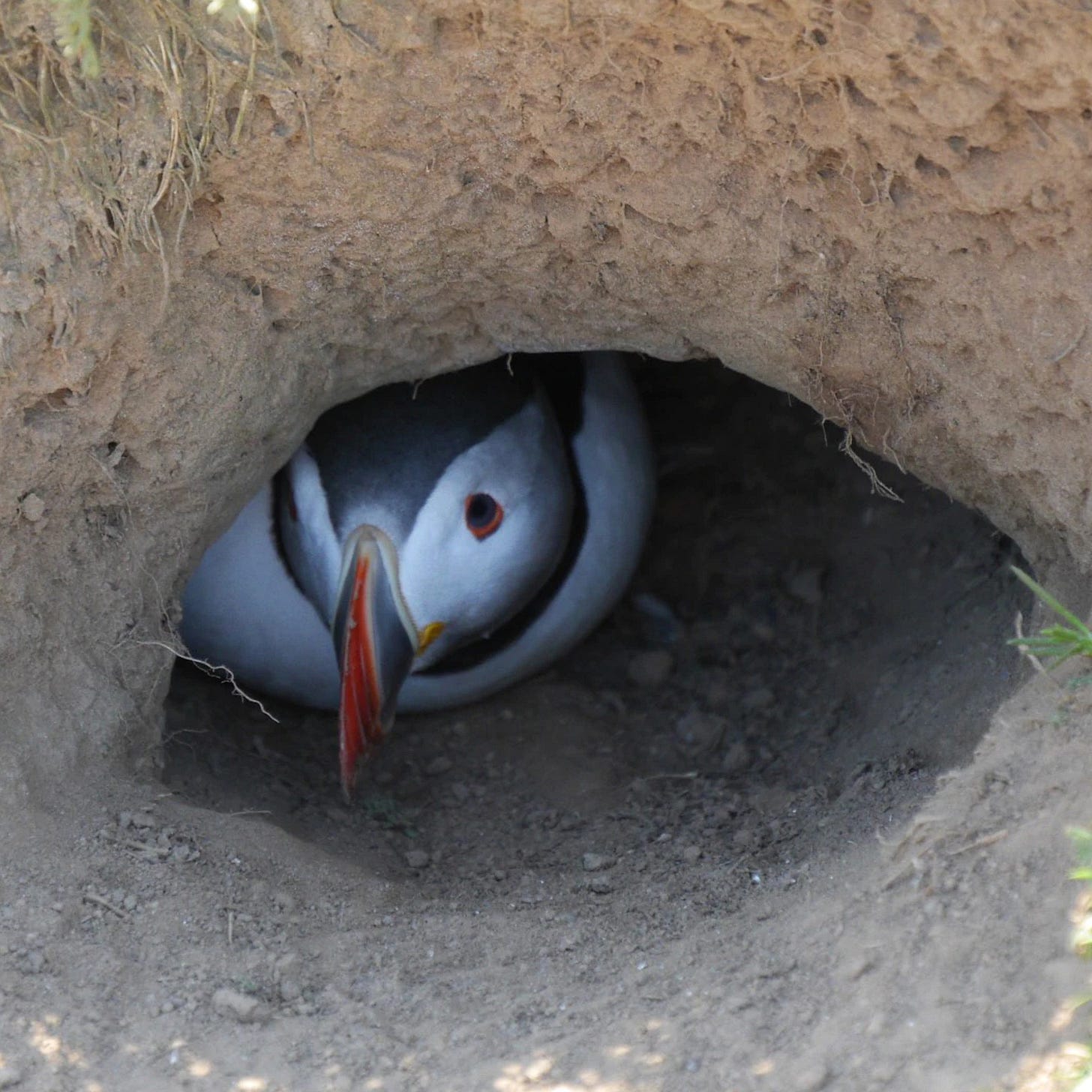There's a spectrum, with boring on one side and weird on the other.
Let’s consider story beginnings, and tinker with the ratio between familiar and strange.
Here's a way to consider beginnings.
Here's a meditation.
You are standing within grasslands stretching in every direction. By your feet, the land is familiar: the plants, the smell of it. But your eye follows a particular path, where you see that the land grows stranger. Out in the distance there are strange caverns that you wonder about, with curiosity and worry.
All between where you stand and those distant, strange lands, there are holes in the ground. Some are burrows, and each burrow has been dug out by a different creature. Each burrow is an entrance into a story. Some burrows are close, some further away, some familiar, and some strange.
Which burrow will you enter? Where will you begin your story?
Perhaps you’ll start with one nearby: a tale of a character who is much like most of us, in the times in which we live. Whose life and way of thinking resembles our own, a starting point for a story that is just like slipping on a familiar sweater and stepping out the door.
Or will the starting point of your story be deeper into that strange terrain, into a hole burrowed by an unfamiliar creature?
That starting point might be a time in the past, not terribly far from our own time, but perhaps a hundred years back. Or a hundred and fifty, or two hundred, into a time that is connected to our own through many visible threads. Perhaps that is the starting point of the story. Or you go further back into times that are difficult for you to imagine, and will be difficult to imagine for those hearing your tale. Difficult, but possible, if you find ways to imagine them deeply, and inhabit those times.
Your story may start a thousand years back. Two thousand! In another world, where people think very differently from ourselves. Or perhaps the characters of your story are not human people. Where does your tale begin? How strange is the burrow’s entrance?
And here is the other question. As you go into that burrow, how quickly and to what degree does the journey become strange?
A story may start with a character who is much like most of your audience, but who quickly steps into an otherworldly world. Or a story may start with someone unfamiliar to us, and then continue more deeply into strange and unfamiliar territory, while hopefully giving us enough details that we can relate with—smells and tastes and feels—that are relatable to us, in our time, with our bodies. Not so different from the bodies in that tale. With enough detail, hopefully, that we can follow this strange character deeper into this strange world.
Not that we all have the same experience now.
How strange is the beginning of your tale to the sensibilities of your listeners? And as the tale deepens, can you bring them with you? If you can, they may be in for the most unusual, deepening, expanding, weirding journey that they've been on since God made platypuses.
Let’s hope so.
For your beginning, you might choose a frame story: a story in which another story takes place.
For example, I’m to a friend, and I begin to tell him about something that happened to me a week ago. The main narration moves to this story from a week ago, but we know we are still within this conversation of me talking with a friend.
There are lots of examples of this. In The Neverending Story, a boy hears his grandfather read a story from a very special book. Within that book is the main story.
Then there's the question of how deeply we go into the frame story. The frame story could be brief, a flitting thought around the main story, where we spend most of our time. In the example of me talking to my friend, we could have a brief conversation between me and my friend, but then most of the narrative is about this story that I'm telling about what happened to me a week ago.
Or, let’s say there's plenty of story going on between me and my friend. We are journeying across the ocean, experiencing various trials and revelations as we go. In the course of all this, time to time I continue telling them about what happened to me a week ago: the story within the frame. In that case, the main emphasis is placed on the frame story and the story within it is not as deeply described.
You can also ask about the relationship between the story that's being framed, and the story that's framing. For example, as we cross the ocean and experience various trials, and I tell my friend about this thing that happened to me a week ago, it could turn out that this thing that happened to me a week ago has a great deal of relevance to what's happening now. It might be just the key to overcoming a particular trial, or convincing him to go a certain direction on the ocean, when we have that chance.
There are different kinds of frame stories. Can you think of some?
Reading a book could be a frame, or a dream, a meditation, a vision, a memory, a letter, or back-and-forth correspondence , a storyteller.
A song could be a frame, and I'm thinking especially of a song with much story in it, like a ballad, those long songs that are histories.
I'm curious if you can think of any more frames for stories. If so, please share them in the comments.
I’ll say one more thing before we close for this session, and it's something you may have been thinking about as I go along, is that stories are not necessarily just one layer deep. You may have a frame story within a frame story, within a frame story…
You might be thinking of the film Inception, in which the frame story is of people trying to get inside the head of someone, to get particular memories. To do this, they share dreams together, and within those dreams they go layers and layers deeper.
For each of the examples I've given, there could be multiple layers of depth. In a conversation, I could be telling my friend about a conversation I had, and how within that conversation another friend was telling me about a conversation they had with a shop-keeper, who was telling about where they got a particular medallion.
You can go as deep as you want.
There's a scripture in India called the Srimad Bhagavatam. The story goes some twelve layers deep: conversations within conversations within conversations within conversations.
And each conversation has some context. We were considering before about how fleshed out the frame story is. So in this case, the first layer is someone who's heard a conversation between the sage and a king, where the sage delivered many teachings. The second layer is the main story in which the king is cursed to die; he goes to the banks of a holy river and prays for guidance.
Many sages gather to him, and one sage in particular comes to speak wisdom to him. Within that story, the sage speaks of other conversations between sages and students. And within those conversations, the sages often quote other sages, because they're not just making it all up. So from sage to sage to sage, it goes twelve layers deep, and some of these layers have more context than others. Some are briefly mentioned, like, ‘Once there was a sage who spoke this to a king, and here is what he spoke.’ Others have more context: ‘There was a battle, and many people had died, and the king was heartbroken, and then the sage appeared to him and spoke the following words…’
So in all these examples of frame stories, these layers can all have relationship with each other, like different floors of the same building, or strata of soil, or layers of a tree with different kinds of branches, or layers of clouds, or perhaps some other metaphor.
If you have started a small business, you might consider the story of how you created that business, the story of why you created that business. You might consider that story to be within the story of your life. So your life is the frame story and the business is the story within it.
If you're helping clients, you might consider which stories are nested within the stories of their lives.
And so…
I couldn't speak about frame stories without coming back to where we started. Let’s come back out of that hole in the ground.
Usually at the end of frame stories, we come out and out of however many frames in we are in, coming back to the first one, which follows the principle of a cycle, of returning to the beginning of a story. Not that it's necessary to return to the beginning of a story, but there is a certain neatness in at least harkening back to the beginning of a story, from the end, of touching back on what brought us into that hole in the ground in the first place.
So as we come out, you may want to reflect on your life as a frame story: around this article, and around all the stories you hear.
That’s one way to think about it.
Story Prompts:
Here are some story prompts regarding the beginning of stories, how normal they are, how quickly they get weird, and how weird they get.
Take a look at a story you're writing and consider that ratio: how weird it starts, how weird it gets, and how weird it finishes. You could try adjusting the recipe to see what happens.
Have it start really weird. Tell it to people. How does it land? Is it intriguing? Do people lean in, or away?
If it starts really normal, is it just boring? How about if it starts normal, then gets really weird… does it throw people off? You can actually get pretty weird if you start normal.
So that's the prompt: to fiddle around with that recipe.
In regards to business, if you have some unusual offering, think about the pathway into it.
And here's some props about frame stories.
The first one is simple: have a conversation with somebody about another conversation. The first one is a frame story. For the second one, if you want to go further it, talk to somebody about what somebody else told you within a conversation that they heard from somebody else, then you're already a couple layers deep into stories.
It's surprising how often we do that in day to day life.
For a frame story within business, you might consider your initial touch with the person to be a kind of frame story. If you're putting on an introductory workshop, this workshop could give a good sense of what your work is like, if you go further and further into it. This workshop could be considered as a frame story, with your customer’s further explorations within that framework being the main story. Kind of like the table of contents and the main book.
You might adjust that first contact so that there's more of the DNA of what's to come in it.
And so here we are, resting in a warm cabin after our journey together.
You can take this time to consider what's alive in you after hearing this talk and to reflect on the story prompts.
Now these prompts art homework. But possibilities. You might respond by journaling, by speaking about them with a friend or colleague, or speaking about them with yourself, while you're walking or driving.
You might push back against these prompts or come up with better ones.
You can share your thoughts in the comments on Substack. Or even better, if you'd like to explore these prompts together, I'm hosting weekly gatherings where we play with stories for an hour that's included for premium subscribers at just $5 a month.
Or you might just want to let this all go and roll along with whatever's coming next in your life.
Happy creating.













